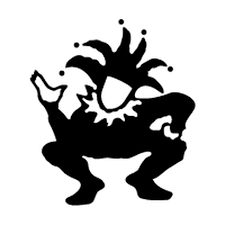DISARMing the Trickster
By Yvan Roy
A workshop I designed suggests how to use the SMART tool DISARM – Destructive Imagery and Self-talk Awareness and Refusal Method – at a meeting or on your own.
1. Develop the Framework – Externalize the Addiction
Talk about how the addiction has come to dominate the participants’ lives and led them to believe that it is much stronger than they are – in fact, serving as addiction’s core strategy for domination. Doing this begins to externalize the addiction. Discuss the relationship tha t participants have with their addiction.
t participants have with their addiction.
Personify or name the addiction / the enemy – Take some time to name the enemy, perhaps with a drawing to further externalize the addition. For example, let’s use the Trickster.
2. Track the Influence of the Addiction / Enemy
Describing their relationship, participants can include:
• The Trickster’s influence on their life, such as their health, work, school, finances, relationships, and relationship with themselves (self-worth, confidence, self-esteem).
• The Trickster’s intention for their life going forward into the future.
• The Trickster’s strategies for dominating their life.
Questions to draw out this information
What does the Trickster make you believe about your addiction that prevents you from moving forward?
How did the Trickster take control of your life?
What is the Trickster getting you to do that goes against your better intentions?
What does the Trickster want for your loved ones, your family, and your children?
What does the Trickster tell you when it wants you to use or behave in an addictive way?
What does the trickster tell you about yourself in order to try to dominate or destroy you and prevent you from acting in your best interest?
Notice that these questions are similar to those used in the ABC exercise in that they invite participants to identify thoughts about their lives, their relationships and themselves that are untrue or unhelpful.
3. Create an Alternative Path
Depending on how far along they are in their recovery, participants next identify how they have begun to fight against the Trickster’s domination or are defeating him, gotten rid of him or learned to stand up to him.
Questions for this discussion
How do you stand up to the Trickster?
How does coming to the SMART Recovery meeting influence your relationship with the Trickster?
What could you do to send the Trickster away or at least scare him a little?
What could you do that would let the Trickster know that you are no longer interested in a relationship with him?
Can you recall a time when the Trickster had less control of your life? What were you doing then?
As you realize that you are not what the Trickster convinced you that you are, what new beliefs do you have about yourself?
What new activities will you be doing that lets the Trickster know he has lost his grip?
4. Role Play
At a meeting, the facilitator asks for two volunteers: one to act as themselves and the other as the enemy or Trickster. I prefer to have the volunteer play their enemy and ask someone who knows the volunteer to play them. You can also just interview the enemy.
The facilitator interviews the enemy about his relationship with the person, and interviews the person about their relationship with the enemy (optional).
An interview with the Trickster might proceed along these lines: Hi, I want to thank you for coming to our group today and agreeing to be interviewed. In this room you have to be completely honest and you have no power to attempt to lie or manipulate. We are interested in knowing how you have succeeded in dominating (the person’s name) life, how you operate, the status of your relationship with (the person’s name) and what your intentions are for his or her future.
5. Participants Debrief and Discuss the Exercise
Interview the person (optional) and ask what he or she learned or thought while listening to the Trickster. Ask the group if they have questions for the Trickster or the person.
Yvan Roy works as an addiction psychotherapist and clinical supervisor in Ottawa, Canada. The agency where he works translated the SMART Recovery Handbook into French; he is working on the facilitator’s manual in order to expand the SMART Recovery program in other parts of the Francophone world. This post is drawn from the handbook and the school of Narrative Therapy of Michael White and David Epson
![]() To read more about the DISARM tool, please visit our website.
To read more about the DISARM tool, please visit our website.
We invite SMART-related blog entries from all interested readers. Entries should have strong pertinence to SMART. Queries are welcome. Send manuscripts or queries to blog@smartrecovery.org

